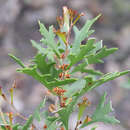en
names in breadcrumbs


Hakea ceratophylla, commonly known as the horned leaf hakea,[2] is a shrub in the family) Proteaceae and is endemic to the southwest of Western Australia. It is a stiff shrub with variably-shaped leaves that are sometimes lobed and flowers with white or rusty-coloured hairs.
Hakea ceratophylla is a stiff, multi-stemmed shrub that typically grows to a height of 0.5 to 2 metres (1.6 to 6.6 ft). Its young branchlets and leaves are covered with rust coloured hairs but become glabrous as they age. The mature leaves vary in shape from linear to narrow egg-shaped with the narrow end towards the base, 4.5 to 23 centimetres (1.8 to 9.1 in) long and 0.2 to 1.4 cm (0.08 to 0.55 in) wide, to leaves with between three and five lobes. Lobed leaves are 3.5 to 8.5 cm (1.38 to 3.35 in) wide with lobes 1 to 26 mm (0.04 to 1.02 in) long. The flowers are arranged in umbels containing between two and ten flowers with no apparent stalk. Each flower has a pedicel 2 to 5 millimetres (0.079 to 0.197 in) long and is covered with white and rust-coloured hairs. The perianth (the non-reproductive part of the flower) is 4.5 to 6 millimetres (0.177 to 0.236 in) long and the style is 7.5–9.5 to 5 millimetres (0.295–0.374 to 0.197 in) long. Flowering occurs from September to December and the black fruit that form afterward are more or less egg-shaped, 2 to 3.5 cm (0.79 to 1.38 in) long and 0.9 to 1.3 cm (0.35 to 0.51 in) wide. The two seeds are 1.2 to 2 cm (0.47 to 0.79 in) long and have a narrow wing down one side.[2][3][4]
The horned leaf hakea was first formally described in 1807 by James Edward Smith who gave it the name Conchium ceratophyllum and published the description in Rees's Cyclopædia. The type specimen was collected at King Georges Sound by Archibald Menzies. Smith noted "It is one of the handsomest of its genus".[5][6] In 1810 Robert Brown changed the name to Hakea ceratophylla.[1] The specific epithet (ceratophylla) is derived from the Ancient Greek words keras, keratos meaning "horn"[7]: 194 and phyllon meaning "leaf"[7]: 605 apparently referring to the leaves which in some forms have horn-like lobes.[4]
The shrub is found in southern areas of Western Australia in the Peel, South West and Great Southern regions of Western Australia where it grows on seasonally damp flats and among granite outcrops in sandy, loamy or gravelly soils.[2] The plants range is from near Perth in the north and south to around Albany and inland to around the Stirling Range area where it grows in heath or Melaleuca woodland communities.[4]
{{cite book}}: |first1= has generic name (help) {{cite book}}: |first2= has generic name (help) Hakea ceratophylla, commonly known as the horned leaf hakea, is a shrub in the family) Proteaceae and is endemic to the southwest of Western Australia. It is a stiff shrub with variably-shaped leaves that are sometimes lobed and flowers with white or rusty-coloured hairs.
Hakea ceratophylla, nommé en anglais horned leaf hakea (hakea à feuilles cornues)[2] est une espèce d'arbuste de la famille des Proteaceae endémique du sud-ouest de l'Australie-Occidentale. C'est un arbuste raide aux feuilles de forme variable, parfois lobées, et aux fleurs aux poils blancs ou rouille.
Hakea ceratophylla est un arbuste rigide à plusieurs tiges généralement de 0,5 à 2 m de haut. Ses jeunes rameaux et ses feuilles sont couverts de poils de couleur rouille, qu'ils perdent en vieillissant. Les feuilles matures sont linéaires ou ovoïdes, resserrées vers la base, longues de 4,5 à 23 cm et larges de 0,2 à 1,4 cm. Elles ont entre trois et cinq lobes. Les feuilles lobées sont longues de 3,5 à 8,5 cm, avec des lobes de 1 à 26 mm de long.
Les fleurs sont disposées en ombelles, contenant entre deux et dix fleurs sans tige apparente. Chaque fleur a un pédicelle de 2 à 5 mm et est couverte de poils blancs et rouille. Leur périanthe (la partie non reproductrice de la fleur) mesure 4,5 à 6 mm de long et leur style de 7,5 à 9,5 mm. La floraison a lieu de septembre à décembre.
Les fruits sont noirs et plus ou moins ovoïdes, longs de 2 à 3,5 cm et larges de 0,9 à 1,3 cm. Ils contiennent deux graines de 1,2 à 2 cm de long, munies d'une aile étroite sur un côté [3],[4]
Hakea ceratophylla a été décrit pour la première fois en 1807 dans la Cyclopædia (en) d'Abraham Rees par James Edward Smith, qui lui a donné le nom de Conchium ceratophyllum. Le spécimen type a été recueilli à King Georges Sound par Archibald Menzies. Smith a noté que « c'est l'un des plus beaux de son genre »[5],[6]. En 1810, Robert Brown a changé son nom en Hakea ceratophylla[1]. Son épithète spécifique (ceratophylla) est dérivée des mots grecs anciens keras, keratos signifiant «corne» [7] :194 et phyllon signifiant «feuille» :605, ce qui renvoie apparemment aux feuilles, dont certaines formes ont des lobes en forme de cornes[4].
Cet arbuste pousse dans le sud de l'Australie-Occidentale, dans les régions de Peel, du South-West et du Great Sourthern, sur des plateaux humides de façon saisonnière et parmi des affleurements de granite dans des sols sableux, limoneux ou graveleux. Son aire de répartition va de la région de Perth au nord jusqu'aux environs d'Albany au sud, et à l'intérieur des terres jusqu'à la chaîne de Stirling, où elle pousse dans les landes ou les forêts de Melaleuca[4].
Hakea ceratophylla, nommé en anglais horned leaf hakea (hakea à feuilles cornues) est une espèce d'arbuste de la famille des Proteaceae endémique du sud-ouest de l'Australie-Occidentale. C'est un arbuste raide aux feuilles de forme variable, parfois lobées, et aux fleurs aux poils blancs ou rouille.